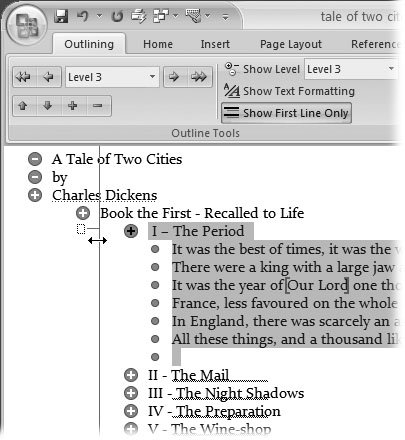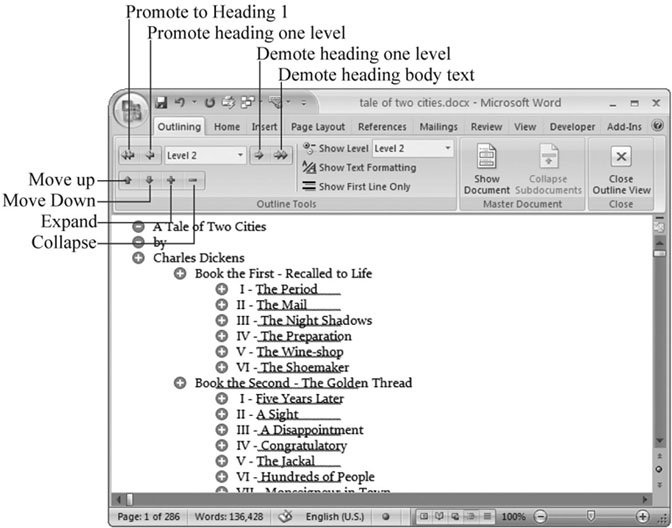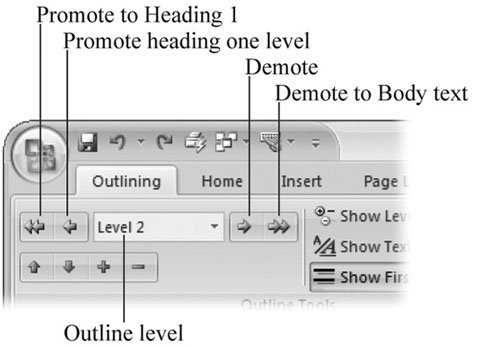8.2. Promoting and Demoting Headings Planning a document is a little bit like putting a puzzle together. You try a piece here and then over there. A topic you thought was minor suddenly looms larger in importance. When you're brainstorming and plotting, it's important to keep an open mind. Word's helpful because it's so easy to try things out, and you can Ctrl+Z to undo whenever you need to. When you promote a topic, you move it toward the left margin. At the same time, it moves up a rank in the headings hierarchy; so, a Level 3 header becomes a Level 2 header, and so forth. For most documents that means the formatting changes too. Higher-level headers typically have larger or bolder typesomething that distinguishes them from their less impressive brethren. To demote a heading is the opposite ; you move a heading toward the right, usually making it a subordinate of another topic. For you, these promotions and demotions are easy. In fact, you encounter a lot less complaining here than you'd find in promoting and demoting employees in your company. The easiest way to promote and demote is to click a header and move it to the left or to the right. When you move it a little bit, a vertical line appears, providing a marker to show you the change in rank, as shown in Figure 8-2.
Note: When you promote or demote a heading, the body text goes with it, but you have a choice whether or not the subheads move below it.
When you're brainstorming and pushing ideas around in your document, you don't want to get distracted by the mechanics. When it comes to outlines, you may be grateful that Word provides so many different ways to do the same thing. You get to choose the method that works best for you, and keep your focus on shaping your document. Word gives you three ways to manipulate the pieces of your outline: -
Dragging . For outlining, nothing's more intuitive and fun than clicking and dragging. You can put some words in a heading, and then just drag them to another location. As you drag topics and text, Word provides great visual clues to let you know the end result (Figure 8-2).  | Figure 8-2. Dragging works well when you're brainstorming. It's satisfying to push, pull, and drag your document into shape as if it were clay and you're the sculptor. As you drag, your cursor changes to a double arrow. The long vertical line indicates the outline level you're currently dragging through. | |
-
Ribbon . The buttons on the Outlining  Outline Tools group give you quick, visual access to the commands for promoting and demoting headings and for showing and hiding all the bits and pieces of your document. Its a bit more mechanical than just clicking and dragging the pieces where you want them (Figure 8-3). Outline Tools group give you quick, visual access to the commands for promoting and demoting headings and for showing and hiding all the bits and pieces of your document. Its a bit more mechanical than just clicking and dragging the pieces where you want them (Figure 8-3). One potentially confusing thing about the Outlining tab are those two drop-down menus showing levels. They look almost identical and both give you a choice among the nine topic levels that Outline has to offer. Here's the key: The menu on the left promotes or demotes the current item, while the menu on the right shows or hides levels. -
Keyboard shortcuts . Keyboard shortcuts are ideal when your hands are already on the keys and you're typing away. During the planning stages, speed isn't as much of an issue, but if you took your teachers ' advice to heart and do lots of outlining, keyboard shortcuts can really streamline your work. Just remember that all these commands use Alt+Shift plus another key, as shown in the table.  | Figure 8-3. The buttons on the Outlining tab provide a command central for promoting and demoting topics and showing just the right part of your document. The up and down buttons move topics forward and backward in the document, providing a great way to move big chunks of text. | |
Table 8-1. | Action | Keyboard Shortcut | | Promote Heading Up a Level | Alt+Shift+Right arrow, or Tab | | Demote Heading Down a Level | Alt+Shift+Left arrow, or Shift+Tab | | Demote Heading to Body Text | Alt+Shift+5 (number pad), or Ctrl+Shift+N | | Expand Outline Item | Alt+Shift++ | | Collapse Outline Item | Alt+Shift+_ | | Expand or Collapse Outline Item | Alt+Shift+A, * key (number pad) | | Show n Level Heading | Alt+Shift+ n , n=number key (top row, not the number pad) | | Show Only First Line of Text | Alt+Shift+L |
Tip: Another keyboard shortcut helps with outlining: the / key on the number pad. That one little key conceals any fancy character formatting you've applied so you can focus on your outline. See Section 8.4.2 for more on the Show/Hide Text Formatting command.
8.2.1. Controlling Subheads During Promotion or Demotion When you promote or demote an outline item, any subheads and subtopics below it move with that item, but only if you collapse the items below, so that they're hidden. In other words, when you move the header above, the subheads keep their relationships even though you can't see them. When you drag topics, the subheads go along, because when you select a topic, you automatically select the subtopics, too. Word gives you a number of ways to move the header but leave everything else where it is. Here's a step-by-step description of the ways you can promote or demote a heading all by its lonesome: -
Click anywhere in the text of the header . Don't select the entire header; just place the insertion point somewhere in the text. -
Change the header level using one of the ribbon buttons or by pressing a keyboard shortcut . Use the shortcut keys Alt+Shift+Left arrow or Alt+Shift+Right arrow to promote or demote the header. As long as the subtopics below aren't highlighted, they won't move when you do the header promoting or demoting. You can use any of the ribbon controls that promote and demote headers in the same way. As long as the subtopics aren't selected, they won't change (Figure 8-4). The buttons that you can use include: Promote to Heading 1, Promote, Outline Level (drop-down menu), Demote to Body Text.  | Figure 8-4. Use the various promotion and demotion buttons and the Level drop-down menu on the Outlining tab to organize your outline. If subheads are collapsed under a topic or they're selected, they maintain their relationships when you demote or promote the header. Otherwise, if only the header is selected, it moves and the subtopics stay put. | |
Note: Working with outlines is actually a lot simpler to do than it sounds. Want to test drive Word's outline features? To check out the screencastan online, animated tutorialof the examples in this chapter, head over to the "Missing CD" page at www.missingmanuals.com.
|

 Outline Tools group give you quick, visual access to the commands for promoting and demoting headings and for showing and hiding all the bits and pieces of your document. Its a bit more mechanical than just clicking and dragging the pieces where you want them (Figure 8-3).
Outline Tools group give you quick, visual access to the commands for promoting and demoting headings and for showing and hiding all the bits and pieces of your document. Its a bit more mechanical than just clicking and dragging the pieces where you want them (Figure 8-3). 
